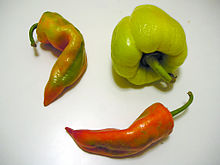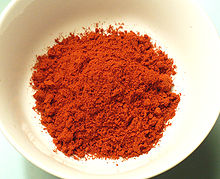 |
|
|
|
|
| Cuisines | Herbal | Spice | Curry | Yeast | Recipe | ||||||
|
Paprika Paprika is a spice made from ground, dried fruits of Capsicum annuum, either bell pepper or chili pepper varieties or mixtures thereof. The seasoning is used in many cuisines to add color and flavor to dishes, but it is usually associated with Hungary, and also Greece, Serbia, Croatia, Bulgaria and Morocco,[1] and also Spain, the latter country having introduced capsicum annuum to the Old World from Southern Mexico. The use of this plant rapidly expanded from Spain throughout Africa and Asia, and ultimately reached Central Europe through the Balkans which were under Ottoman rule, explaining the Slavic origin of the modern English term. In Spanish, Paprika has been known as Pimenton since the 1500s, when it became a typical ingredient of the western region of Extremadura.[2] Despite its presence in Central Europe since the beginning of Ottoman conquests, it did not become popular in Hungary much more than one hundred years ago. Central European paprika was hot until the 1920s, when a Szeged breeder found one plant that produced sweet fruit. This was grafted onto other plants.[4] Nowadays, paprika can range from mild to hot, and flavors also vary from country to country, but almost all the plants grown produce the sweet variety.[4] The sweet paprika is mostly pericarp with more than half of the seeds removed, whereas hot paprika contains some seeds, placentas, calyxes, and stalks. In many European languages, but not in English, the word paprika also or only refers to the Capsicum fruit itself. Usage Paprika is produced in a number of places including Hungary, Serbia, Spain and California.[8] It is used as an ingredient in a broad variety of dishes throughout the world. Paprika is principally used to season and color rices, stews, and soups, such as goulash, and in the preparation of sausages as an ingredient that is mixed with meats and other spices. In the United States, paprika is frequently sprinkled on foods as a garnish, but the flavor is more effectively produced by heating it gently in oil. Spanish Paprika (Piment髇) is available in three versions, mild (Piment髇 Dulce), moderately spicy (Piment髇 Agridulce), and very spicy (Piment髇 Picante.) Some Spanish paprika, including Piment髇 de la Vera has a distinct smokey flavor and aroma as it is dried by smoking, typically using oak wood. Paprika can also be used with henna to bring a reddish tint to hair when coloring it. Paprika powder can be added to henna powder when prepared at home. Nutrition Capsicum peppers used for paprika are unusually rich in vitamin C, a fact discovered in 1932 by Hungary's 1937 Nobel prize-winner Albert Szent-Gy鰎gyi.[12] Much of the vitamin C content is retained in paprika, which contains more vitamin C by weight than does lemon juice. |











